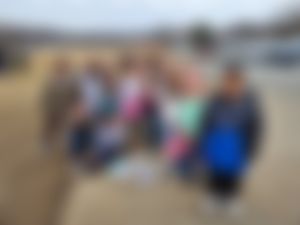Systemic Sustainability
Environmental Curriculum and Instruction
1.1 Curriculum and Instruction
Elementary & middle schools must provide one example of outdoor/environmental instruction per grade level.
High schools must provide one example of outdoor/environmental instruction in four subjects (which may include multiple different differents sciences).
The teacher read the students the book Rain Fish written by Lois Ehlert. After reading, the teacher facilitated a discussion with the students on the importance of reusing materials. The class discussed everyday materials that could be reused in order to eliminate waste. After the discussion, the teacher provided the students with scraps of paper, used brown paper bags, pieces of used foil, and used gift bags. The students were then instructed to use the materials to create a piece of art.
Classroom teachers introduced the Green School initiative with their students by first showing "The Lorax" and following up with a discussion about ways they could help the Earth. The students then made posters to share how they can care for the Earth.
The second-grade teachers also conducted a lesson on energy conservation. The classes discussed the importance of conserving energy and the ways in which they could do so. Each second grader made a light switch plate. The plates have reminders written on them. They were placed around light switches throughout the building to encourage others to power down lights when they are not in use.
Second graders shared how they can care for the Earth by creating posters that were displayed in the hallways.
Second graders brainstormed and shared ideas about how they can care for the Earth.
Second graders created posters sharing how they can care for the Earth.
Examples of light switch plate covers designed and created by second graders.
An example light switch plate cover created by a second grader.
2nd Grade Green School Project_ Turn of the lights! (857.97 KB)
This is a copy of the Google slides the second-grade teachers used to introduce a lesson on energy conservation.
The Maryland Extension presented a lesson to all first-grade classes. The representatives from the Extension taught the students about monarch habitats and explained which plants would need to be planted in our monarch waystation. The visitors shared photos and seed samples with the classes. The students learned information about butterflies, and how they eat and pollinate. The students participated in a dress-up demonstration and in a hands-on butterfly tagging activity. They discussed migration and the importance it plays in pollination. The students learned that fruits, vegetables, and nuts require pollination.
A lesson in grade one on monarch habitats facilitated by the Maryland Extension.
Students examining seed samples.
Students participated in a butterfly tagging activity.
Students reenacted the life cycle of a butterfly and the butterfly's role in pollination.
Students determined which seeds to plant in our school's monarch waystation.
Fair Hill Nature Center visited all three kindergarten classes at Bay View Elementary. During the lesson, the students learned about hibernation, migration, and adaptations to the environment during the change of the seasons. Kindergarten also discussed animals in their habitats and sorted pictures placing animals in their correct habitats. The children were introduced to Bernate, Fairhill's turtle, and learned what he needs to survive.
During a visit from Fair Hill Nature Center, the kindergarteners learned about animals and their habitats.
During a visit from Fair Hill Nature Center, the kindergarteners learned which animals hibernate, which ones migrate, and why. They also learned about how some animals adapt to survive in their environment.
The students in third grade learned about the importance of keeping the environment clean. Trash can make its way into streams and animals can be harmed by trash as well. Third-grade students saw a need to clean up the outdoor play area around the school. They worked as a class to pick up trash and debris to reduce litter and ensure a safe place to play.
The Cecil County Department of Public Works Stormwater Management Division visited the fourth-grade classes at Bay View Elementary. The visitors explained that Bay View is part of a watershed. The students learned about how the water in the area drains to the Chesapeake Bay and how important it is to ensure that pollutants do not drain into the bay. The Department of Public Works is currently installing a sand filter behind Bay View Elementary. The students learned about erosion and how the stream behind the school has been affected by erosion. The Public Works division taught the students about plants that are native to our area and planned with the students the appropriate flowers to plant in the school's rain garden to encourage pollination and prevent erosion.
Fourth graders learned about native plants that would thrive on school property.
The visitors from the Department of Public Works explained the importance of the watershed to our community.
The students discussed possible projects they could initiate and fulfill to help the Chesapeake Bay Watershed.
A representative from the Division of Public Works taught the fourth graders about native plants that would thrive in the school's rain garden.
The fourth graders learned about native plants that would thrive in the school's rain garden.
The fourth graders voted on which grasses and plants should be planted in the school's rain garden.
Fifth grade learned about the Chesapeake Bay watershed and had a meaningful watershed educational experience. Students first took a walking tour around the outside environment of the school and wrote about observable phenomena. From that observable phenomenon, students created a driving question to target their action plan. The students' driving question was, "how do we fix the bare spots throughout the schoolyard?" Bare spots are places where vegetation no longer exists in the soil, with the outcome being that stormwater can no longer soak into the land. This causes the runoff water to go into storm drains or into streams. The fifth graders researched the best ways to solve this problem and will be constructing a plan to fix the bare spots the week of March 13th.
Fifth-grade students observe the grounds around the school building to find observable phenomena and create driving questions.
Fifth-grade students recorded their observations about the conditions of the school grounds.
The students recorded observations about potential environmental problems around the school grounds.
1.2 Green School Awareness
1.2.1 School Wide Awareness - Staff
Demonstrate that all school personnel are aware of your school's Green School status and application process.
At Bay View Elementary, we have a Green School committee that meets once per month. After each meeting, the committee shares its goals and progress with the entire staff. The Green School committee also planned and prepared a presentation for teachers to share with their students. This presentation explained what a Green School involves and emphasized ways students and teachers can support school-wide efforts to maintain our Green School status.
At the opening of the school year on August 25, 2022, the entire staff was made aware that we would be seeking Green School Re-Certification. We discussed what that meant and encouraged staff members to join the committee. Our Green School Committee met and reported monthly to the staff sharing the application progress as well as what activities were happening around the school.
This is the opening day of the school year PowerPoint presentation that was used to explain to staff that we would be reapplying for Green School Certification.
Green Team Agenda - 9.14.22 (147.6 KB)
This is the September Green School Committee meeting agenda.
Green Team Agenda - 10.12.22 (150.24 KB)
This is the October Green School Committee agenda.
Green Team Agenda - 11.9.22 (158.29 KB)
This is the November Green School Committee agenda.
Green Team Agenda - 12.14.22 (165.3 KB)
This is the December Green School Committee agenda.
Green Team Agenda - 1.25.23 (159.53 KB)
This is the January Green School Committee agenda.
1.2.2 School-Wide Celebration
Demonstrate how your school celebrates beig a Green School by hosting a school-wide environmentally-focused event open to all students.
We held a schoolwide celebration in December 2022 to make the school aware of the Green School process and we will continue to do so annually.
In December we set aside a day to make sure our school was aware of our Green School Re-Certification Process. Each grade level was given a lesson to use with their students to introduce them to the concept of a Green School and how each class would work to fulfill our mission. Older students took part in a Kahoot game to test their knowledge while younger students thought of ways that they could help the Earth. This will be annual event.
Second-graders designed and created posters sharing the importance of caring for the Earth.
Second-graders designed and created posters sharing the importance of caring for the Earth. These posters were displayed in the hallways.
Pre-kindergarten students created illustrations showing ways in which they and others can care for the Earth. These were displayed in the hallways.
Pre-kindergarten students created illustrations showing ways in which they and others can care for the Earth.
Pre-kindergarten students created illustrations showing ways in which they and others can care for the Earth.
Students in grade four watched the movie "The Lorax" by Dr. Seuss. After viewing the movie, the teachers facilitated a discussion on the importance of conserving resources and caring for the Earth.
Students in grade four completed a "Kahoot" activity. During this activity, students demonstrated what they learned about energy and resource conservation. These three students earned the highest score on the activity.
Students in grade four completed a "Kahoot" activity. During this activity, students demonstrated what they learned about energy and resource conservation.
Bay View Green School Celebration (169.25 KB)
This is an email sent to staff members sharing the activities that would be used with the students to explain the Green School launch.
Environmental Professional Development for Teachers
1.3.1 Environmental Professional Development for Teachers
Demonstrate that 10% of staff have completed an environmental PD. Instructional staff is defined as any staff that manages a gradebook.
- New Schools must have all PD completed within the past 2 academic years.
- Renewing schools must have all PD completed within the past 4 academic years.
A teacher who has participated in multiple workshops may only be counted once..
42 staff members including 19 out of 21 teachers attended a professional development on how our school would be reviving our school recycling program and start participating in a food waste recycling program.
Mr. Barczewski led a full-staff professional development covering two topics focused on recycling. The first part of his presentation covered the importance of recycling and what items within our school can be recycled. He introduced the launching of an initiative to ensure that students and staff are using the blue recycling bins for recycling papers. This practice has not been consistent throughout the school in recent years. He also introduced the launch of a food waste recycling program. Food scraps from the cafeteria will be placed in special bins. The food scraps will be picked up and used at a local dairy farm. The scraps will be placed into a biodigester which will convert the scraps to energy.
Mr. Barczewski led a professional development opportunity explaining the importance and benefits of recycling.
The presentation reviewed why it is necessary to recycle in our school. Jason Wallace attended the presentation.
Recycling Presentation - 2.7.2023 (1.08 MB)
These are the Google Slides that were shared with the staff at Bay View Elementary. The slides emphasize the importance and benefits of recycling. The objective was for the teacher to learn how we could recycle within the school and use our food waste for a positive purpose.
Green School PD Sign-In (781.71 KB)
Sign-in sheet from the PD session.
Mr. Barczewski led a full-staff professional development covering two topics focused on recycling. The first part of his presentation covered the importance of recycling and what items within our school can be recycled. He introduced the launching of an initiative to ensure that students and staff are using the blue recycling bins for recycling papers. This practice has not been consistent throughout the school in recent years. He also introduced the launch of a food waste recycling program. Food scraps from the cafeteria will be placed in special bins. The food scraps will be picked up and used at a local dairy farm. The scraps will be placed into a bio-digester which will convert the scraps to energy.
The presentation reviewed why it is necessary to recycle in our school. Bethany Buckley attended the presentation.
Recycling Presentation - 2.7.2023 (1.08 MB)
These are the Google Slides that were shared with the staff at Bay View Elementary. The slides emphasize the importance and benefits of recycling. The objective was for the teacher to learn how we could recycle within the school and use our food waste for a positive purpose.
Green School PD Sign-In (781.71 KB)
Sign-in sheet from the PD session.
Mr. Barczewski led a full-staff professional development covering two topics focused on recycling. The first part of his presentation covered the importance of recycling and what items within our school can be recycled. He introduced the launching of an initiative to ensure that students and staff are using the blue recycling bins for recycling papers. This practice has not been consistent throughout the school in recent years. He also introduced the launch of a food waste recycling program. Food scraps from the cafeteria will be placed in special bins. The food scraps will be picked up and used at a local dairy farm. The scraps will be placed into a bio-digester which will convert the scraps to energy.
The presentation reviewed why it is necessary to recycle in our school. Alissa Sisson attended the presentation.
Recycling Presentation - 2.7.2023 (1.08 MB)
These are the Google Slides that were shared with the staff at Bay View Elementary. The slides emphasize the importance and benefits of recycling. The objective was for the teacher to learn how we could recycle within the school and use our food waste for a positive purpose.
Green School PD Sign-In (781.71 KB)
Sign-in sheet from the PD session.
1.4 Achieving Sustainable Schools
1.4.1 School-Wide Staff Sustainability
Demonstrate the sustainability practices your teachers, staff, and other personnel have implemented school-wide to make your school green. Any actions involving students belong under Objective 2.
Bayview Elementary School launched a school-wide food waste recycling program. The staff was trained on the importance of recycling and plans were developed for explaining the expectations to the students. The teachers then delivered lessons to the students on the importance of recycling and the steps that would be followed. As the students exit the cafeteria, they pour any remaining liquids into a designated receptacle. The students then place food waste in a second receptacle. Any remaining trash is placed in a third designated receptacle. Lastly, the students recycle their trays. The cafeteria staff members monitor students as they recycle to ensure the proper collection of food scraps. The food waste is collected by a volunteer on the weekends and delivered to a local dairy farm.
The staff at Bay View prepare to begin a school-wide food waste recycling program.
These posters remind the students of where to place trash, food waste, and liquids. There are three separate bins in the cafeteria. The students place trash in one. Food waste is placed in another and all liquids in a third bin.
Students place trash in a designated bin.
Students place all food waste in a designated bin. This food is picked up weekly and taken to a biodigester at a local dairy farm.
1.4.2 Systemic Partnership
Demonstrate one partnership with a central office or board within the school system that supports part of the Maryland Green Schools Program. Any partnerships outside of your school system belong under Objective 3.
Cecil County Public School Facilities, specifically the electrical department, replaced all of the light fixtures throughout the school building, including the hallways, classrooms, cafeteria, and gymnasium. The light fixtures were replaced with energy-efficient LED lights. 145,601 kWh will be saved in a year.
The lights in every classroom at Bay View Elementary were replaced with LED lights. These lights are more energy-efficient and cost-effective.
The lights in every hallway at Bay View Elementary were replaced with LED lights. These lights are more energy-efficient and cost-effective.
The cafeteria light fixtures were replaced with LED lights.
Student Action
Schools must document eight total actions that address at least three of the listed sustainability practices.
These are student actions not adult actions. Adult sustainable actions can be documented in Objective 1.4.
2.1 Water Conservation/Pollution Prevention
2.1 Water Conservation/Pollution Prevention
No records were added by the school.
2.2 Energy Conservation
2.2 Energy Conservation
The students in grade two designed light switch plate covers. These covers have phrases written on them that serve as reminders to turn off the lights and any electronic devices when not in use in the classroom. The goal of these posters is to encourage both the staff and the students at Bay View Elementary to conserve energy. The plate covers have been added to classrooms and offices throughout the building.
Delmarva Power provided each student in our building with a reusable bag filled with educational materials, ten LED light bulbs, and one LED desk lamp. The students learned the advantages of using LED lights and the benefits of these lights for the environment. In turn, the students educated their parents on the importance of using LED lights in their homes. Students frequently talk about using their desk lamps at home.
The Judy Center in partnership with Delmarva Power and MegaLight Inc. handed out reusable bags filled with educational materials, LED light bulbs, and an LED desk lamp to each student at Bay View Elementary.
This is a third-grade student sharing the contents of the bag students received from Delmarva Power and MegaLight. The bag contained an LED desk lamp, LED light bulbs, and tips on how to conserve energy at home.
MegaLight Card- shared with Families.docx (133.53 KB)
A brief notice to parents indicating the contents of their child's bag and who donated the materials.
The Judy Center MegaLight_Delmarva Proposal 2022.docx (55.31 KB)
A letter from the Judy Center thanking MegaLight Inc. for their partnership.
2.3 Solid Waste Reduction
2.3 Solid Waste Reduction
Water bottle filling stations were installed in 2018 and 2019. The school custodial staff continues to maintain these stations. At the start of the school year, students are encouraged by their teachers to bring reusable water bottles to school. Students and staff fill up their water bottles as needed. The use of the water bottle filling stations has drastically cut the amount of plastic waste used throughout the building.
Students deposit food waste during lunch in designated receptacles. These scraps, which would have typically gone to the landfill, are taken to a biodigester. These scraps are recycled into energy to power a local dairy farm.
Students practice placing food waste into the proper receptacles.
Students practice placing food waste into the proper receptacles.
Fourth graders recycling food waste.
Fifth graders recycling food waste.
Cafeteria Posters Portrait (1) (398.7 KB)
These are posters that are displayed in the recycling area of the school cafeteria.
2.4 Habitat Restoration
2.4 Habitat Restoration
This fall, Bay View Elementary established a Green Team Club. The club's first project was to clean out the birdhouses located around the school property. The birdhouses on our school's property contained old nests. These nests potentially contained bacteria and mites that would be harmful to new inhabitants. The old nests also discouraged new birds from nesting in the houses. The birdhouses needed to be cleaned in order to provide a safe nesting space for future birds. The students met after school, learned about the importance of the birdhouses, and spent time cleaning and preparing the houses for the next nesting season.
The Green Team Club built new bird feeders. The students first learned the importance of bird feeders to the health and survival of local bird species. The students next used a map of the school to determine where the new feeders would be placed. Then, the students worked in teams to follow a set of written directions to build their feeders. The students decorated the new bird feeders. These bird feeders will provide an additional food source for birds on school grounds. The hope is that the feeders will attract different species of birds for the students to observe.
Members of the Green Team Club work cooperatively to build bird feeders.
Members of the Green Team Club work cooperatively to build bird feeders.
Members of the Green Team Club work cooperatively to build bird feeders.
Members of the Green Team Club work cooperatively to build bird feeders.
Members of the Green Team Club built and decorated bird feeders that will be placed on school grounds.
2.5 Opportunities for Nature Exploration
2.5 Opportunities for Nature Exploration
In spring of 2022, construction on an outdoor classroom began. This classroom was created through a partnership with aspiring leaders from Cecil Community College. In addition, York Building Products donated rocks. Each student at Bay View Elementary designed and painted a rock in art class that was placed around the outdoor classroom. These rocks add to the beauty of the space and are an individual contribution from each student at Bay View Elementary.
York Building products donated and laid stone for Bay View's outdoor classroom.
Each student at Bay View decorated a rock that was placed around the outdoor classroom.
Each student at Bay View decorated a rock that was placed around the outdoor classroom.
Each student at Bay View decorated a rock that was placed around the outdoor classroom.
The Green Team Club spent an afternoon weeding and cleaning up trash in the rain and flower gardens on school grounds. They pulled weeds, raked leaves, and threw away any trash that was found.
Members of the Green Team Club cleaned up trash and weeded the rain garden.
Members of the Green Team Club cleaned up trash and weeded the rain garden.
Members of the Green Team Club cleaned up trash and weeded the rain garden.
Members of the Green Team Club clean up trash throughout the school gardens.
2.6 Responsible Transportation
2.6 Responsible Transportation
No records were added by the school.
2.7 Healthy Indoor Environments
2.7 Healthy Indoor Environments
No records were added by the school.
2.8 Citzen/Community/Participatory Science
2.8 Citizen/Community/Participatory Science
No records were added by the school.
Community Partnership
Demonstrate that your school is forming long-term partnerships to foster environmental stewardship and cultivate community wellness through real-world connections.
3.1 Community Partnerships
3.1.1 School Active in Community
Describe at least one environmentally-focused partnership in which your school is working to benefit your community.
Members of the Cecil Leadership Institute, along with students, evaluated the condition of an already existing nature trail behind our school. They then worked to restore the nature trail and make it user-friendly again. Families were informed of the restored trail and the fact that it is available to all students during the school day. Community members are welcomed and encouraged to enjoy the nature trail when school is not in session.
3.1.2 Community Active in the School
Describe at least one partnership in which a community partner is benefitting the school. These actions and projects occur on or near school grounds with support from the partner.
First graders were visited by a representative of the Cecil County Extension Office. The representative educated the students on how to prepare a monarch waystation. Students will plant seeds and plants in a designated area that will attract and provide food for butterflies. When the students become second graders next year, they will hatch butterflies in the fall and release them in a welcoming environment.
The Extension Office provides the second-grade classrooms with caterpillars that eventually, develop into Painted lady butterflies. The students observe and care for the caterpillars through their metamorphosis into a chrysalis and then into a butterfly. The students will release the butterflies into their environment.
The Cecil County Extension Office visits the first-grade classrooms at Bay View Elementary. The guests taught the students about the habitats of monarch butterflies.
The students examined seed samples.
The students participated in a butterfly tagging activity.
The students reenacted the lifecycle of a butterfly.
The students decided which flowers and plants to plant in the school's monarch waystation.
Extension Email (234.15 KB)
This pdf shows the email exchange between Bay View and UMD-Extension to show when they would be coming into our building to partner with us.
The Cecil County Department of Public Works is leading a stream restoration project behind our school. Members of the department have educated our fourth graders on this process and connected the process to their learning unit on weathering, erosion, and deposition. Students will learn about the Chesapeake Bay Watershed and actively participate in the project by choosing native plants that will attract pollinators to the newly restored area and also plants that will help to prevent erosion.
Students learned about native plants that attract pollinators.
The fourth graders learned that Bay View is a watershed.
The fourth-grade students brainstormed and discussed possible projects they could initiate to ensure the health of the Chesapeake Watershed.
The fourth-grade students learned about the watershed and how its fish and other animals are affected by pollution.
Public Works Email (188.1 KB)
This pdf shows the email exchange coordinating the visit of Public Works and our partnership.
York Building Products donated a stone base for our outdoor classroom, as well as, larger stones that students were able to paint to decorate the outdoor classroom.
York Building Products donated and laid the stone for the base of Bay View's outdoor classroom.
Each student at Bay View Elementary painted a rock, donated by York Building Products. These rocks were placed throughout the outdoor classroom as decoration.
Bay View Elementary Donation - York (621.66 KB)
This pdf shows the email exchange between Bay View and York Building Products to show when they would be coming into our building to make a donation of stone.
3.2 Additional Achievements
3.2 Additional Achievements optional
Share any environmentally-related awards, special recognition, certifications, or other achievements that your school, staff or students have accomplished.
No records were added by the school.























































































